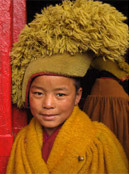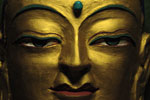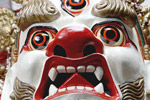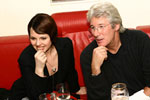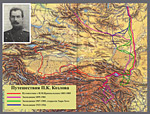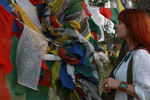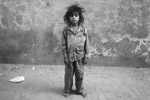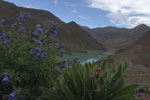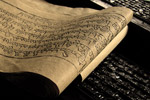History of Tibetan Panchen Lamas lineage
In Tibetan Buddhism the Panchen Lama is the second-highest lama after the Dalai Lama. Like the Dalai Lama, the Panchen Lama is of the Gelug school of Tibetan Buddhism.
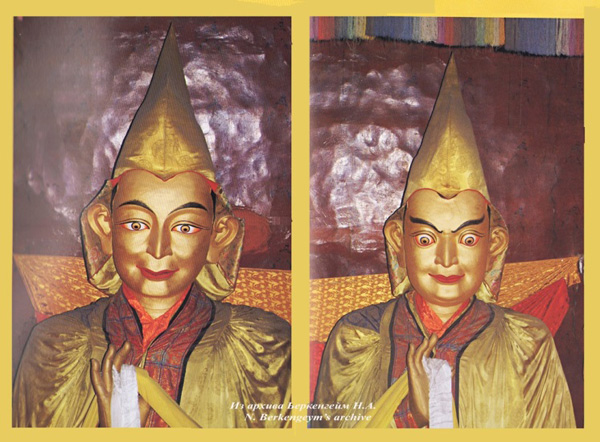
The two main scholars, Je Tsongkhapa: Jyaltsab Darma Rinchen (left)
and Kedrub Geleg Pelzang (right).
Photo from the Tashi Lhunpo Monastery in Tibet.
Khedrup Gelek Pelzang, the 1st Panchen Lama (1385-1438), better known as Khedrup Je, was one of main disciples of Tsongkhapa whose reforms in Atisa’s Kadam tradition are considered the beginnings of the Gelug school of Tibetan Buddhism. By the decision of the 5th Dalai Lama, Khedrup Je was posthumously named as the previous incarnation of Lobsang Chokyi Gyalsten, the 4th Panchen Lama (1570-1662).
Like all the Panchen Lamas, he is considered to be an incarnation of Amitabha Buddha. Traditionally, there were considered to be four Indian and three Tibetan incarnations before Khedrup, starting with Subhuti, one of the original disciples of Gautama Buddha. Khedrup was one of the founders of Gelug who, as considered, promoted and defended Tsongkhapa's work.
Khedrup Je was unanimously chosen as Ganden Monastery's third abbot (after Tsongkhapa and Gyaltsab Je) by its monks, and also became the Ganden Tripa, the leader of the Gelug tradition. According to the legend, after Tsongkhapa died in 1419, his disciple Khedrub Je on five occasions met with him in mystical states. Khedrub Je is most remembered for his charisma as a teacher, as well as for the many excellent commentaries that he wrote on the tantric lineages which Tsongkhapa gathered together and elucidated. He played an important role in the education of the First Dalai Lama, who was the youngest of Tsongkhapa's five main disciples.
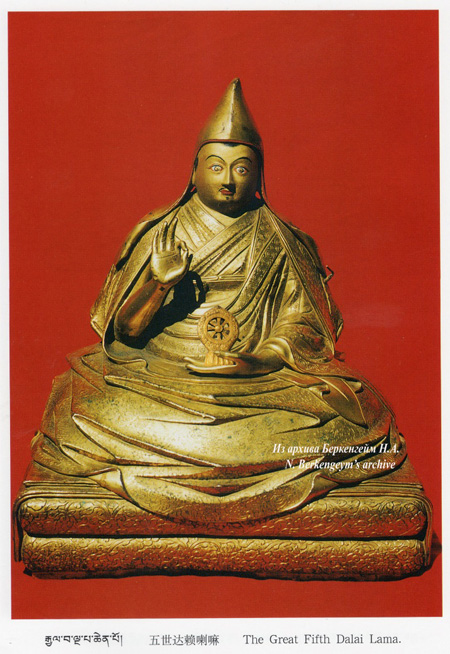
Fifth Dalai Lama. Photo from the Tashi Lhunpo Monastery in Tibet.
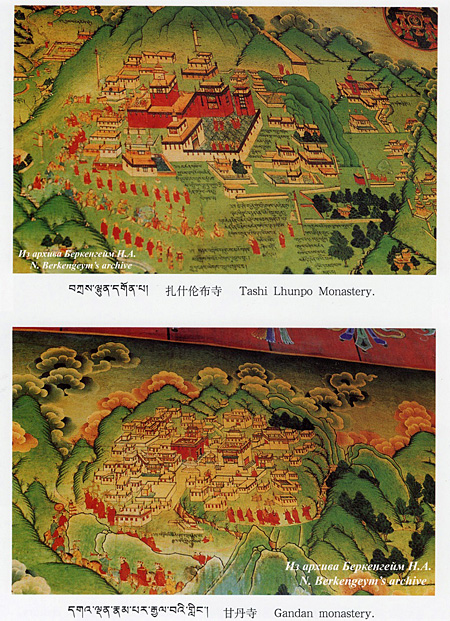
Monastery of Tashi Lhunpo and Gaden Namgyal. Mural of Tashi Lhunpo Monastery in Tibet.
In 1418 he founded Palcho Monastery in Gyantse as well as the large Riwo Chöling Monastery in the Yarlung Valley which is now just in ruins.
Khedrub Je had written multiple books on Buddhist philosophy comprising of nine volumes including all fifty-eight treatises. Besides, he wrote many prayer books. Khedrub Je wrote the important text on Kalachakra which till now the 14th Dalai Lama uses as the basis for His public initiations of the Kalachakra Tantra. Khedrub Je also wrote the root text for Mahamudra.
After Khedrup's death a Tibetan boy named Sonam Choklang (1438-1505) was recognized as his tulku, or rebirth. So a lineage of reborn lamas was established. However, these first Panchen Lamas did not hold the title during their lifetimes.
The title “Panchen Lama”, meaning “the Great scholar”, was given by the 5th Dalai Lama to the fourth lama in Kherup's lineage. This lama, Lobsang Chokyi Gyalsten (1570-1662), is remembered as the 4th Panchen Lama, although he was the first lama to hold the title in his life. Being a spiritual descendent of Khedrup, the Panchen Lama also is considered to be an emanation of Amitabha Buddha. Along with his role as a teacher of the Dharma, the Panchen Lamas usually are responsible for recognition of Dalai Lamas’ rebirths (and vice versa).
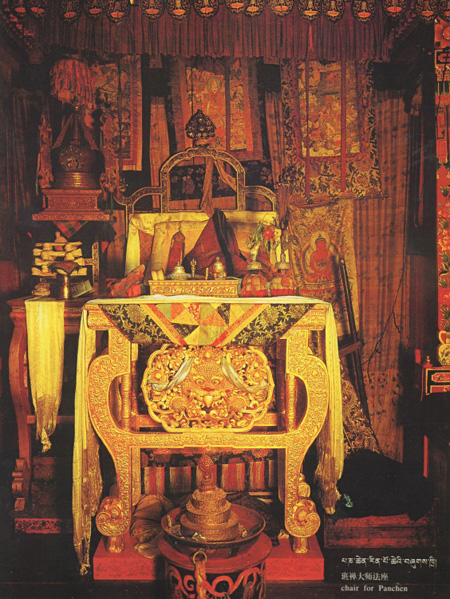
Throne of Panchen-lam in Tashi Lhunpo Monastery in Tibet.
The reincarnations line from the First to the Eleventh Panchen Lama
1. Khendup Geleg Namgyal Pelsang
(student of Je Tsongkapa)
(1385-1438)
2. Sonam Choki Lanpo
(1439-1504)
3. Logsang Dondrup
(1505-1566)
4. Panchen Lama
Lobsang Chokyi Gyaltsen
(1570-1662)
(the title Panchen Lama was given to this
incarnation lineage by the 4th Dalai Lama)
5. Panchen Lama
Lobsang Yeshe
(1663-1737)
6. Panchen Lama
Lobsang Palden Yeshe
(1738-1780)
7. Panchen Lama
Lobsang Tenpe Nyima
(1782-1853)
8. Panchen Lama
Lobsang Palden Choki Dragpa Tenpe Wangchuk
(1855-1882)
9. Panchen Lama
Lobsang Thubten Choki Nyima
(1883-1937)
10. Panchen Lama
Lobsang Trinley Lhudup Chokyi Gyaltsen
(1938-1989)
11. Panchen Lama
Tenzin Gendün Yeshe Tinle Phuntsog
(25th April 1989- )
Since the time of Lobsang Chokyi Gyalsten, the Panchen Lamas have been involved in Tibet's government and relations with powers outside Tibet. In the 18th and 19th centuries in particular the Panchen Lamas often had more real authority in Tibet than the Dalai Lama, especially through a series of Dalai Lamas who died too young to have had much influence.
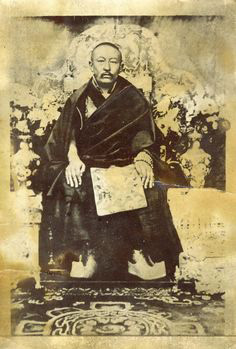
Ninth Panchen Lama of Tibet Lobsang Thubten Choki Nima. Photo from the archive by Matthieu Ricard.
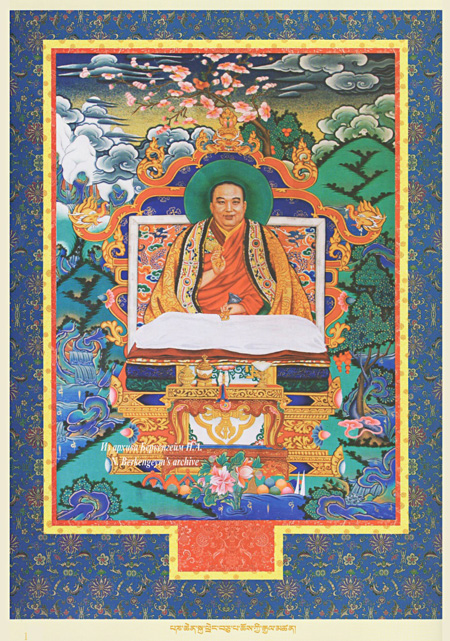
Tenth Panchen Lama of Tibet Lobsang Trinley Lhundrup Chokyi Gyaltsen
The two high lamas have not always been congenial co-rulers. A serious misunderstanding between the 9th Panchen Lama and 13th Dalai Lama caused the Panchen Lama to leave Tibet for China in 1923. It became clear that the 9th Panchen Lama was a closer ally to Beijing than to Lhasa and did not agree with the Dalai Lama's opinion that Tibet was independent from China.
The 11th Panchen Lama
And like the Dalai Lama, the Panchen Lama has been tragically impacted by China's subjugation of Tibet. The current Panchen Lama, His Holiness Gedhun Choekyi Nyima, is missing and possibly dead. In his place Beijing has enthroned a pretender, Gyaltsen Norbu, who serves as a conduit for Chinese propaganda about Tibet.
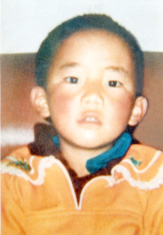
The last photo of the Eleventh Panchen Lama of Tibet Gedun Choki Nyima
On May 14, 1995, the Dalai Lama identified a six-year-old boy named Gedhun Choekyi Nyima as the 11th reincarnation of the Panchen Lama. Two days later the boy and his family were taken into Chinese custody. They have not been seen or heard from since. Beijing named another boy, Gyaltsen Norbu - the son of a Tibetan Communist Party official - as the 11th Panchen Lama and had him enthroned in November 1995.
Raised in China, Gyaltsen Norbu was kept out of public view until 2009. Then China began to push the teenager onto the world stage, marketing him as the true public face of Tibetan Buddhism (as opposed to the Dalai Lama). Norbu's primary function is to issue statements praising the government of China for its wise leadership of Tibet. Most of Chinese people accept this fiction; Tibetans do not.
![]()
![]()
![]()
![]()
